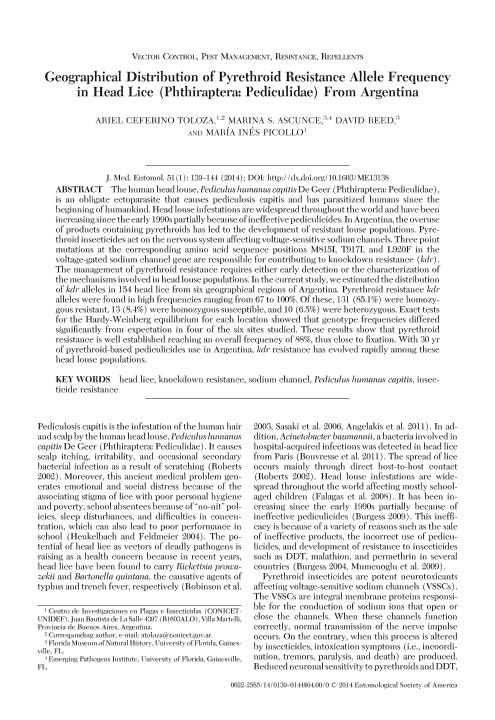Mostrar el registro sencillo del ítem
dc.contributor.author
Toloza, Ariel Ceferino

dc.contributor.author
Ascunce, Marina Sofia

dc.contributor.author
Reed, David
dc.contributor.author
Picollo, Maria Ines

dc.date.available
2017-12-06T16:46:08Z
dc.date.issued
2013-09
dc.identifier.citation
Toloza, Ariel Ceferino; Ascunce, Marina Sofia; Reed, David; Picollo, Maria Ines; Geographical Distribution of Pyrethroid Resistance Allele Frequency in Head Lice (Phthiraptera: Pediculidae) From Argentina; Entomological Society of America; Journal of Medical Entomology; 51; 1; 9-2013; 139-144
dc.identifier.issn
0022-2585
dc.identifier.uri
http://hdl.handle.net/11336/29831
dc.description.abstract
The human head louse, Pediculus humanus capitis De Geer (Phthiraptera: Pediculidae), is an obligate ectoparasite that causes pediculosis capitis and has parasitized humans since the beginning of humankind. Head louse infestations are widespread throughout the world and have been increasing since the early 1990s partially because of ineffective pediculicides. In Argentina, the overuse of products containing pyrethroids has led to the development of resistant louse populations. Pyrethroid insecticides act on the nervous system affecting voltage-sensitive sodium channels. Three point mutations at the corresponding amino acid sequence positions M815I, T917I, and L920F in the voltage-gated sodium channel gene are responsible for contributing to knockdown resistance (kdr). The management of pyrethroid resistance requires either early detection or the characterization of the mechanisms involved in head louse populations. In the current study, we estimated the distribution of kdr alleles in 154 head lice from six geographical regions of Argentina. Pyrethroid resistance kdr alleles were found in high frequencies ranging from 67 to 100%. Of these, 131 (85.1%) were homozygous resistant, 13 (8.4%) were homozygous susceptible, and 10 (6.5%) were heterozygous. Exact tests for the Hardy-Weinberg equilibrium for each location showed that genotype frequencies differed significantly from expectation in four of the six sites studied. These results show that pyrethroid resistance is well established reaching an overall frequency of 88%, thus close to fixation. With 30 yr of pyrethroid-based pediculicides use in Argentina, kdr resistance has evolved rapidly among these head louse populations.
dc.format
application/pdf
dc.language.iso
eng
dc.publisher
Entomological Society of America

dc.rights
info:eu-repo/semantics/openAccess
dc.rights.uri
https://creativecommons.org/licenses/by-nc-sa/2.5/ar/
dc.subject
Head Lice
dc.subject
Knockdown Resistance
dc.subject
Sodium Channel
dc.subject
Pediculus Humanus Capitis
dc.subject
Insecticide Resistance
dc.subject.classification
Otras Ciencias Biológicas

dc.subject.classification
Ciencias Biológicas

dc.subject.classification
CIENCIAS NATURALES Y EXACTAS

dc.title
Geographical Distribution of Pyrethroid Resistance Allele Frequency in Head Lice (Phthiraptera: Pediculidae) From Argentina
dc.type
info:eu-repo/semantics/article
dc.type
info:ar-repo/semantics/artículo
dc.type
info:eu-repo/semantics/publishedVersion
dc.date.updated
2017-12-04T19:07:39Z
dc.identifier.eissn
1938-2928
dc.journal.volume
51
dc.journal.number
1
dc.journal.pagination
139-144
dc.journal.pais
Estados Unidos

dc.journal.ciudad
Lanham
dc.description.fil
Fil: Toloza, Ariel Ceferino. Consejo Nacional de Investigaciones Científicas y Técnicas. Unidad de Investigación y Desarrollo Estratégico para la Defensa. Ministerio de Defensa. Unidad de Investigación y Desarrollo Estratégico para la Defensa; Argentina. Consejo Nacional de Investigaciones Científicas y Técnicas. Instituto de Investigaciones Científicas y Técnicas para la Defensa. Centro de Investigación en Láseres y Aplicaciones; Argentina
dc.description.fil
Fil: Ascunce, Marina Sofia. University of Florida; Estados Unidos
dc.description.fil
Fil: Reed, David. University of Florida; Estados Unidos
dc.description.fil
Fil: Picollo, Maria Ines. Consejo Nacional de Investigaciones Científicas y Técnicas. Unidad de Investigación y Desarrollo Estratégico para la Defensa. Ministerio de Defensa. Unidad de Investigación y Desarrollo Estratégico para la Defensa; Argentina. Consejo Nacional de Investigaciones Científicas y Técnicas. Instituto de Investigaciones Científicas y Técnicas para la Defensa. Centro de Investigación en Láseres y Aplicaciones; Argentina
dc.journal.title
Journal of Medical Entomology

dc.relation.alternativeid
info:eu-repo/semantics/altIdentifier/doi/http://dx.doi.org/10.1603/ME13138
dc.relation.alternativeid
info:eu-repo/semantics/altIdentifier/url/http://www.bioone.org/doi/abs/10.1603%2FME13138
Archivos asociados
